
In recent weeks, reports from various Russian sources have confirmed the delivery of a new batch of advanced T-90M Proryv tanks to the Russian armed forces. Concurrently, the official communications office of Uralvagonzavod (UVZ), Russia’s preeminent tank manufacturing facility, has announced a tripartite escalation in the production output of their flagship tank model, the T-90M Proryv.
UVZ’s statement elucidated, “Over the preceding year, the manufacturing complex has trebled the provision of both novel and enhanced tanks. Our current endeavor is focused on further amplifying this production surge. Consequently, the prevalence of T-90 tanks within the military echelons is experiencing a steady augmentation.”
Despite this augmentation, the T-72B3M iteration remains the predominant constituent of the Russian ground forces’ tank inventory. UVZ persists in elevating stored T-72 tanks to the B3M standard. The current proportional ratio of T-72 to T-90 tanks in active service approximates 1 to 3.
The contention arises: Is the T-90M the ultimate zenith in tank engineering? Several commentators from Russia and Eastern military analysts contend that the T-90M Proryv achieves apex status among global tank models. Their contention posits that only the British Challenger 2 can rival it in direct confrontation. By juxtaposition, they contend that the German Leopard 2 and other Western tanks wane when measured against the T-90, particularly in terms of vital tank attributes encompassing armor resilience, firing cadence, precision, and operational range.
The T-90 stands as the paragon of robustness and protection among Russian tanks. The T-72’s merit lies in its reliability, while the T-80 garners acclaim for its impressive velocity. Each tank serves a distinct tactical niche. Notably, UVZ’s production ambit extends beyond the T-90M Proryv, encompassing an upgraded iteration dubbed the Proryv Ver.3, in accordance with insights from Russian military discourse.
The T-90M Probiv-3 garners recognition as a stalwart bastion against a spectrum of assaults, including those perpetrated by unmanned aerial vehicles (UAVs) and missiles originating from diverse nations. However, critics posit that the efficacy of this tank hinges on the incorporation of a comprehensive active protection system, as opposed to discrete components.
Not all T-90 tanks are outfitted with an Active Protection System (APS). Nevertheless, the T-90 tank has underscored its durability by enduring an unprecedented barrage of impacts, thereby showcasing its operational efficacy even in the absence of a fully integrated Afganit APS. Given the substantial expense associated with active defense systems, it becomes pragmatically unfeasible to outfit each tank with the Afganit.
An Active Protection System, abbreviated as APS, encompasses sensors that proactively detect incoming projectiles and respond by deploying counter-projectiles of its own. Essentially, it functions as a bespoke anti-aircraft safeguard for the tank.
A pivotal rationale behind the absence of Afganit APS in all T-90M Proryv tanks is its prohibitive cost. Despite the vast scale of the Russian economy, ongoing sanctions have imposed constraints on the procurement of indispensable materials and components.
Assuming the accuracy of Uralvagonzavod’s claims, with an estimated monthly production of approximately 300 tanks, the full implementation of APS in each tank becomes a near-impossible feat. The substantial financial outlay, coupled with the scarceness of vital electrical and laser components, transforms the production of 300 units of Afganit APS into a formidable undertaking.
So, what precisely constitutes the Afganit APS?
Crafted in Russia, the Afganit active tank defense system represents cutting-edge technology meticulously devised to shield tanks from imminent threats like missiles and rockets. Operating as a hard-kill mechanism, it harnesses an amalgamation of sensors, radar systems, and a rapid-fire gun to spot and neutralize incoming projectiles before they impact the tank.
Engineered to synergize with other tank defense mechanisms such as armored plating and reactive armor, the Afganit system possesses the capability to engage multiple threats concurrently, thereby elevating its efficacy as a defensive asset in combat scenarios.
Boasting an effective range spanning approximately 50 meters, the Afganit system can thwart threats originating from all compass points and is especially adept at countering close-quarter combat situations. This attribute proves particularly advantageous in urban warfare contexts where tanks often operate in proximity to structures and buildings.
The Afganit system has been subjected to extensive testing and has incontrovertibly showcased its effectiveness in safeguarding tanks against imminent threats. Presently integrated by the Russian military, it garners recognition as one of the most sophisticated active defense systems on a global scale.
In summation, the Afganit active tank defense system epitomizes a sophisticated and efficient technological solution that furnishes tanks with a substantial echelon of protection against impending threats. Its fusion of sensors, radar capabilities, and rapid-fire ordinance render it a potent defense system proficient in simultaneously engaging diverse threats from all angles.
Afganit APS Contenders
The Afganit Active Protection System (APS), a pioneering Russian creation, is strategically crafted to safeguard military vehicles against potent threats such as anti-tank missiles and rocket-propelled grenades. However, this intricate system faces formidable rivalry from Western counterparts.
Among these contenders, the Trophy APS, conceived by Israel’s Rafael Advanced Defense Systems, and the Iron Fist APS, developed by Israel’s IMI Systems, stand out. Analogous to the Afganit APS, these competitors harness cutting-edge radar and sensor technologies to forecast incoming threats and initiate countermeasures, thus thwarting any potential harm to the vehicle.
Another prominent Western challenger surfaces in the form of the Quick Kill APS, an innovation from the American defense powerhouse, Raytheon. While sharing the attributes of threat detection and countermeasure deployment with the Afganit and other APS models, Quick Kill distinguishes itself by employing a laser to obliterate impending threats, diverging from the mere interception or deflection approach.
The APS market serves as a crucible of intense competition, where multiple Western corporations vie for supremacy. Notable among these are Germany’s Rheinmetall AG with their ADS APS, Britain’s QinetiQ with their Dragonfire APS, and the American defense titan Lockheed Martin with their Multi-Function Active Protection System (MAPS). Each of these systems brings distinctive strengths and capabilities to the forefront, imbuing the market with a dynamic and fiercely competitive landscape.




